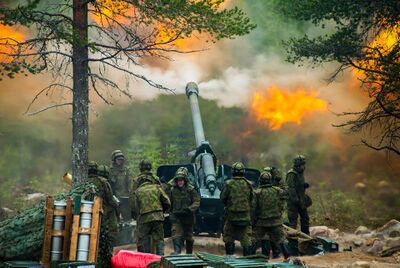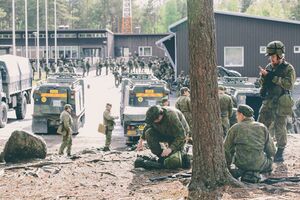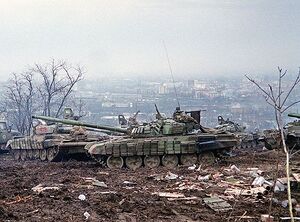Battle of Sarud
The Battle of Sarud was an battle in the Zemplen War fought between 21 September to 8 October 2008 in and around the city of Sarud in northern Ruvelka.
Following the commencement of Operation Aspis, Army Group Alpha of the Syaran National Army had pushed along highway M9 towards the city of Sarud, hoping to use it as a staging ground to encircle the bulk of Ruvelkan Army Group North between Sarud and Kaposvár. The city was defended by the remnants of the Ruvelkan Fifth Army and the recently mobilized 10th Army, along with a collection of Territorial Defense Forces and Imperial Fusiliers. The Syarans assaulted Ruvelkan positions outside Sarud starting on 21 September and by the 25th had pushed the Ruvelkans beyond the bisecting M10 Highway. To avoid encirclement by flanking Syaran corps the Ruvelkans fell back, but counterattacked on 3 October to halt further Syaran advances. Major fighting ceased around 8 October, with the Syarans steadily expanding their zone of control until the Ruvelkan Winter Counter-Offensive later that year.
Background
The city of Sarud is located 84 kilometers from the Syara-Ruvelka border, slightly west and roughly in between the larger cities of Kaposvár (98 kilometers to the north) and Kunhegyes (63 kilometers to the south). Sarud is a major transportation hub of the Kunhegyes District, straddling the east-west Highway M9, and the north-south Highway M10, which connects Kaposvár and Kunhegyes. Following the outbreak of fighting in May 2008 the Ruvelkan Fifth Field Army was mobilized in the vicinity of Sarud. Originally assigned to defend the M9 by the Imperial General Staff, the army was given new orders to assist in Ruvelkan forces in Imerti following the Syaran August Offensive. Ruvelkan forces were expelled from Imerti by 9 August and withdrew back into Ruvelka to regroup.
On 18 August Syaran Executive Dragomir Zhelev declared a unilateral ceasefire, but with Syara now controlling all the disputed border regions, Chancellor Edviná Molnár declared that Ruvelka would not negotiate so long as Ruvelkan soil was occupied by Syara. The Syaran ceasefire was broken shortly after 2100 local time when the Ruvelkan Imperial Air Force bombed Syaran positions in Zemplen and Imerti. Convinced that the Syaran Commonality Armed Forces could inflict a decisive defeat on the Imperial Armed Forces of Ruvelka, SCAF Central Command Chief of Staff Vakhtang Avakian ordered the execution of Operation Aspis to begin on 14 September.
Between 19 August and 14 September the Ruvelkan forces in the Kunhegyes District received conflicting orders regarding their objectives. On 22 August Lt. General Szimonetta Lengyel, commanding Fifth Army, was ordered by Army Group North Headquarters to shift her forces south in preparation for a counter-offensive into Imerti, but these were countermanded by the Imperial General Staff on the 26th after Ruvelkan intelligence detected the build of Syaran forces across the border. On 23 August the Syaran National Army stood up Army Group Alpha, which was assigned to northern Ruvelka and the destruction of Ruvelkan military forces within its area of operations. Syaran mobilization proceeded faster than Ruvelka's, which was compounded by confusion regarding allocation of resources between the Army, the Fusiliers, and the Territorial Defense Force. By 5 September, the Syarans had mobilized the 7th Army along the border, consisting of three corps of four divisions each. Despite the presence of the 7th Army, the Ruvelkan Fifth Army was ordered to reorient itself south-west along the Kunhegyes-Sagerejo District border towards Imerti, where the Syaran 3rd Army was mobilizing. On 7 September the Syarans stood up the 2nd Army, though it would not be combat ready by 14 September.
The Syarans launched Operation Aspis with a preliminary bombardment of Ruvelkan border outposts in the early morning. Airstrikes from the Commonality Air Force neutralized forward airfields near the border, and by 0600 the Syaran 7th Army had crossed the border and was moving east. Recognizing that Fifth Army was not in position to repel the Syarans, Lengyel ordered her forces to withdraw west, rather than be caught in a pincer between the Syaran flanking corps of 7th and 3rd Army. Not wanting to give the Syarans a straight shot to Sarud, Lengyel ordered the Fifth Army and what TDF units were ready to attack the advance guard of the Syaran main body, hoping to slow down the Syarans long enough to re-deploy the bulk of Fifth Army into the path of 7th Army. It was ultimately not enough as the Syarans routed the TDF units attempting to hold the M9, and the Ruvelkan 15th Cavalry Division was decimated by the combined strength of the Syaran 9th and 46th Mechanized Infantry Divisions. By 20 September what remained of the Fifth Army had reached the outskirts of Sarud and assumed hasty defensive positions, hoping to stall the Syarans long enough for the still mobilizing Tenth Army to reinforce them.
Course of the battle
Syaran drive
7th Army had a prescribed strength of 12 divisions, with three corps of four divisions each. The Syarans advanced towards Sarud in standard offensive formation, IX Corps forming the center with two divisions front and two back, with II Corps to the north on the right flank and I Corps in the south on the left flank of the army's advance. By Operation Aspis the Syarans were still in the process of mobilization but had managed to bring army's combat power to roughly 80-85% of its expected strength. Having neutralized local airfields utilized by the Ruvelkan Imperial Air Force, the Commonality Air Force bombed strategic targets in Sarud, while also dropping leaflets urging the civilian population to flee. The Ruvelkan forces of Fifth Army had taken up defensive positions on the western outskirts of Sarud consisting of a three division front, running from north to south were the 14th, 20th, and 27th Infantry Divisions.
Sarud is surrounded by rough and rocky hills to the north and thick forests to the south, which prevented the Syarans from launching an immediate encirclement of the city. Syaran forces began probing Ruvelkan defenses on the 21st before withdrawing at nightfall. During the night of the 21st-22nd Syaran artillery shelled the villages and towns of Rétoldal, Szigetkert, Bököny, and Újfehértó. At around 0645 on 22 September a tank column from the 271st Armored Brigade of the 27th Mechanized Infantry Division assaulted Ruvelkan positions in Bököny. Before noon two battalions of Syaran mechanized infantry had siezed the hills surrounding the village and began pouring mortar fire on Ruvelkan forces within; a counterattack by local Territorial Defense Forces failed to dislodge the Syaran and the Ruvelkans were forced to abandon Bököny in the late afternoon.
Disagreements between Syaran commanders surfaced on how best to tackle Sarud. Field Marshal Nikodemos Cvetkov, commanding Army Group Alpha, wanted to bypass the city, having learned from his comrades in Army Group Gamma about the difficulty in tackling the Ruvelkan fortress city of Albertirsa. Colonel General Simeon Karandzhulov, commander of 7th Army, instead believed he could punch through the Ruvelkan defenses based on the assumption that the Ruvelkan Fifth Army had been badly mauled in fighting near the border, and would not be able to effectively resist the Syaran assault. On 25 September Karandzhulov ordered Lt. General Amynta Matzic of IX Corps to push through and sieze Újfehértó, the last major town between the Syarans and Sarud, but Matzic was wary of pushing further east until the Syarans had seized Rétoldal and Szigetkert first.
Syaran forces from the 16th Mechanized Infantry Division assaulted Rétoldal and Szigetkert on 26 September, and by the next day had routed Ruvelkan forces within the vicinity. At around 1430 on 26 September the 14th Infantry Division launched a counter-attack against Syaran forces that had captured Szigetkert, but after six hours of fighting the Ruvelkans were forced to call off the attack as increasingly accurate Syaran artillery began shelling the Ruvelkan's staging area and command posts. On 27 September the Syaran 272nd Mechanized Brigade, supported by three battalions of mechanized infantry from the rest of the 27th Division and a tank battalion from the 162nd Armored Brigade attacked Ruvelkan forces in the vicinity of Újfehértó. The Ruvelkan 20th Infantry Division resisted the assault for 11 hours, but by 2000 hours the Ruvelkan position was beginning to collapse as Syaran tanks rolled into the central square of the town. Shortly after midnight on the 28th General Lengyel ordered the Fifth Army to fall back and withdraw east into Sarud and the surrounding area.
The Ruvelkans regrouped west and attempted to hold the M9 junction in the middle of the city with the 202nd Infantry Regiment, supported by three companies of KH2 Ghost tanks and TSPJ1 Uhlans, but a "thunder run" by the freshly introduced 392nd Armored Cavalry Brigade ruptured the Ruvelkan defensive perimeter and forced the Ruvelkans to abandon central Sarud to the Syarans. At 1530 on 28 September Syaran troops from Delta Company, 3rd Battallion, 392nd ACB raised the Syaran flag above the Sarud City Council chambers.
Ruvelkans regroup
Fifth Army pulled back east around the outskirts of Sarud on 28 September, and by the 29th had reformed a defensive line roughly 15 kilometers from the city center. By now the Tenth Army under Lt. General Péter Márton had formed the bulk of its forces ready for action and began reinforcing the Fifth Army's positions east of Sarud. Scattered fighting between the Ruvelkans and Syarans continued on the eastern outskirts of Sarud as the Syarans expanded their security zones. Elsewhere the Syarans had solidified their positions around Sarud, with II Corps holding position in the north facing Kaposvár and the Ruvelkan Third Army, while in the south I Corps faced towards Kunhegyes and the still mobilizing Sixth Army. Although the Ruvelkans held an advantage in numbers, with almost 500,000 troops against 350,000 Syarans, the Ruvelkans were short on heavy weapons, and many of their tanks and artillery pieces were outclassed by their Syaran counterparts.
7th Army commander Colonel General Karandzhulov wanted IX Corps to expand its forward security zone to the town of Érpatak, which held the only major bridge across the Akhal River. IX Corp's commander, Lt. General Amynta Matzic, felt the objective was too optimistic and wanted to focus on securing the flanks of his forward divisions, which he felt were too exposed and vulnerable to counter-attack. Matzic did not believe that the other corps of 7th Army would be able to support his own forces should the Ruvelkans strike back, and wanted to wait until the 7th Army's position was more secure. General Karandzhulov however overruled such concerns, eager to secure a better strategic position before the Ruvelkans had time to rush more reinforcements into the area. On 1 October Amynta rotated the 78th Mechanized Infantry Division through to begin pushing towards Érpatak.
Lengyel desired an immediate counter-attack against Syaran forces in Sarud, but General Márton didn't believe that the fresh Tenth Army and battered Fifth Army had the offensive firepower to drive the Syarans out of Sarud. Once the Ruvelkan Imperial General Staff learned of the danger of Syaran forces crossing the Akhal, and therefore being in position to turn either north towards Kaposvár or south towards Kunhegyes, outflanking either the Third or the Sixth Army. As a result the two armies were ordered to counter-attack and prevent the Syarans from crossing the Akhal. Ruvelkan signal intercepts managed to learn that the Syarans intended to launch their assault on 3 September. Lengyel ordered the Fifth Army's two remaining divisions, the 20th and 27th Infantry, as well as the 46th and 28th Infantry Divisions from Tenth Army to pinch off the forward element of IX Corps held by the 78th and 16th Mechanized Infantry Divisions.
At Lengyel's urging, the Third and Sixth Army were to carry out their own local counterstrokes against the Syaran I and II Corps with the main purpose of tying down Syaran resources and preventing them from reinforcing IX Corps. Neither Army was in much position to truly upend the Syaran Corps, but the rough terrain both were operating limited Syaran options when it came to maneuvers or actions.
Ruvelkan counter-attack
The Ruvelkans struck early in the morning of 2 September with airstrikes against Syaran positions along the outskirts of Sarud. Originally the Syarans did not realize the extent of the Ruvelkan operation and believed it was general harassment, and 16th Mechanized Infantry Division responded by shelling Ruvelkan positions in Érpatak. Ruvelkan infantry backed up by HH1 helicopter gunships and KH2 tanks began pressing Syaran positions in north-east Sarud around 0725. Under repeated attacks by Ruvelkan gunships and numerous infantry units sneaking through Syaran lines the 161st Mechanized Brigade began to withdraw deeper into Sarud, hoping to goad the Ruvelkans into a pitched urban battle where Syaran superiority in firepower could win out.
Ruvelkan efforts to chase the Syarans back to Sarud were undercut by heavy shelling from Syaran artillery, and more than a dozen CAS sorties from the Commonality Air Force. Syaran air support proved costly, with Ruvelkan air defenses shooting down two Syaran Corvix light attack aircraft. Around noon the Syarans in return downed an HH1 attack helicopter, and damaged another with ground fire. The north-east attack, carried out by the 20th Infantry Division, began to falter in the face of heavy Syaran fire and by 1535 the order was given to halt and regroup. Efforts to pin the bulk of the 16th Mechanized Infantry Division by the 46th Infantry Division proved futile in the face of Syara tanks and heavy armor, who repulsed three assaults by Ruvelkan mechanized forces between 0915 and 1430.
In the south-east the Ruvelkans intially faced limited success, with the 27th Infantry Division unbable to make any significant headway against the 78th Mechanized Infantry Division. Syaran artillery and local counter-attacks by Syaran armored forces repulsed Ruvelkan assaults all throughout the morning, and by noon it looked as if the attack was falling apart. Fortunes changed when the 282nd Infantry Regiment of the 28th Infantry Division managed to slip among the wooded areas amid Sarud's outskirts and appear on the southern flank of the 782nd Mechanized Brigade, which was holding the Syaran front line. Aware of the threat of their exposed flank but lacking the ability to secure the forest with what manpower they had, the Syarans instead had their engineering teams lay down a minefield as protection.
Initial Ruvelkan reluctance quickly gave way to opportunity as the Ruvelkan forward platoons realize that the Syarans had only laid down anti-tank mines; the Syarans having assumed the Ruvelkans would attempt a mechanized flanking maneuver as the Syarans would themselves have done. Realizing they themselves would not be heavy enough to set off the Syaran AT mines, the Ruvelkan infantry dismounted and crossed the minefield, stunning the 782nd's supply battalion. The sudden appearance of nearly 1,000 Ruvelkan infantry within their tactical rear threw the 782nd Brigade into disarray, made even greater when the Ruvelkans captured the brigade's headquarters and destroyed its communication nexus. With the 782nd Brigade now falling apart at the seams, the entire division began to unravel as Ruvelkan light infantry poured through Syaran lines. Isolated Syara tanks and armored vehicles were destroyed, supplies were seized and the Ruvelkans threatened to push back into Sarud.
Recognizing the impending disaster, Lt. General Matzic ordered the still recovering 27th Mechanized Infantry Division to immediately counterattack into the 78th's area of operations. With the position teetering near total collapse, the 273rd Mechanized Brigade struck back against the 282nd Infantry Regiment amid the outer districts of Sarud and within the 78th's AO, resulting in chaotic and sporadic engagements. Realzing the large enemy force they were facing with superior firepower, the Ruvelkans dispersed into small groups and began holing up in various structures throughout Sarud's outskirts, forcing the Syarans to clear out sectors one by one, frequently relying on heavy artillery to flatten entire blocs and areas. Fighting continued well into the night until the last batches of Ruvelkan troops slipped back across to friendly lines or were either killed or captured. Despite the heavy pressure on the 78th Mechanized Infantry Division, the Ruvelkans were ultimately unable to successfully collapse the division. Failure on the rest of the front led to General Lengyel to call off the attack on 4 September.
After rallying to defeat the Ruvelkan assault, the Syarans attempted another drive on Érpatak on 6 September, but stiff Ruvelkan resistance yielded little results. By this point the Syarans were running low on fuel and many of their vehicles were in need of repair or damaged beyond use. Colonel General Karandzhulov reluctantly called off the attack on 8 September, by which point many of the other Syaran armies in Ruvelka had halted their operations, and as such is often considered to mark the end of Operation Aspis.
Aftermath
Sarud was a chaotic battle in most respects, with both sides able to claim victory. Despite Syaran efforts in capturing Sarud, the inability to cross the Akhal River proved a major obstacle for Army Group Alpha, and the position of the Ruvelkan Fifth and Tenth Army became the staging ground for Ruvelkan northern operations during the Ruvelkan Winter Counter-Offensive. The Syarans would eventually capture Érpatak and cross the Akhal during Operation Harpe, which would also bring about the capture of Kaposvár and Kunhegyes. For the Ruvelkans the battle was seen as a success for bringing Operation Aspis to a close, while also demonstrating the ability of Ruvelkan infantry to outmaneuver and slip through Syaran forces.



